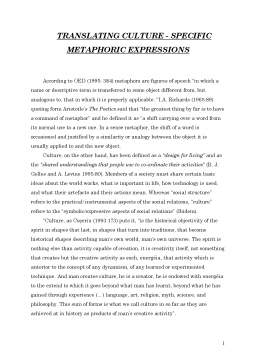Extras din proiect
According to OED (1995: 384) metaphors are figures of speech “in which a name or descriptive term is transferred to some object different from, but analogous to, that in which it is properly applicable. “I.A. Richards (1965:89) quoting form Aristotle’s The Poetics said that “the greatest thing by far is to have a command of metaphor” and he defined it as “a shift carrying over a word from its normal use to a new one. In a sense metaphor, the shift of a word is occasioned and justified by a similarity or analogy between the object it is usually applied to and the new object.
Culture, on the other hand, has been defined as a “design for living” and as the “shared understandings that people use to co-ordinate their activities” (R. J. Gelles and A. Levine 1995:80). Members of a society must share certain basic ideas about the world works, what is important in life, how technology is used, and what their artefacts and their actions mean. Whereas “social structure” refers to the practical/ instrumental aspects of the social relations, “culture” refers to the “symbolic/expressive aspects of social relations” (Ibidem).
“Culture, as Coşeriu (1993:173) puts it, “is the historical objectivity of the spirit in shapes that last, in shapes that turn into traditions, that become historical shapes describing man’s own world, man’s own universe. The spirit is nothing else than activity capable of creation, it is creativity itself, not something that creates but the creative activity as such, energéia, that activity which is anterior to the concept of any dynamism, of any learned or experimented technique. And man creates culture, he is a creator, he is endowed with energéia to the extend to which it goes beyond what man has learnt, beyond what he has gained through experience (…) language, art, religion, myth, science, and philosophy. This sum of forms is what we call culture in so far as they are achieved at in history as products of man’s creative activity”.
Ortega y Gasset stated that a translator must be in possession of not only a genius of a language but of two. When referring to language and translation he said that “if compared to any other, each language has its own linguistic style or what Humboldt called <an internal form>. He (apud Graur 1970:63) pointed out that “more languages mean more conceptions upon the world (Weltansichen)”.
He also demonstrated that language determines thought as well as a particular vision upon the universe. “Any linguistic system comprises within itself an analyses of the exterior world, an analyses which is its own and which is different from that of the other languages or from the other stages known by that particular language”. (Ibidem)
This is why it is a utopia to imagine that two words from two different languages presented in the dictionary as the translation of the other one refer to exactly the same things. Every language was formed within a definite landscape and depending on a distinct and non-repeatable experience. It is a fallacy to assume, for example, that the English expression “to call a spade a spade” (OED 1995:159) is to be rendered as such into Romanian, that is by “a numi cãzmaua lopatã”. We need to take into account the fact that when trying to translate, we should preserve the semantic as well as the stylistic equivalencies of what has been expressed in the source text. Therefore, a more appropriate translation would be “a spune lucrurilor pe nume”(DEX 1984:510) as this is the Romanian expression that renders the exact same message.
1. An Overview of Culture-Specific Metaphoric Expressions
The need for a more dramatic rendering of thought led to the creation of expressions that represent the way in which we usually think or act. They are linguistic instances of conceptual metaphors. However, as Johnson and Lakoff (1982) put it, they are so ordinary “that we do not recognize their metaphorical character.”
According to Avãdanei (1994:16) metaphor is present in “absolutely all perceived dimensions of human existence” being not a matter of words but conceptual in nature. It is the main mechanism through which we comprehend abstract concepts and perform abstract reasoning. Metaphors, as noticed by Lakoff (1993: 245) “allow us to understand a relatively abstract or inherently unstructured subject matter in terms of a more concrete or at least more highly structured subject matter.”
Preview document
Conținut arhivă zip
- Translating Culture - Specific Metaphoric Expressions.doc


























